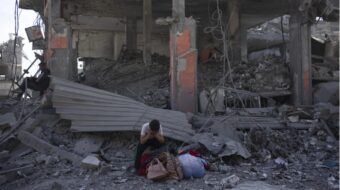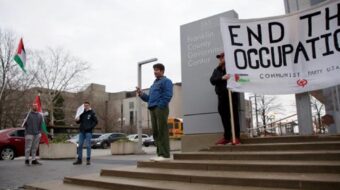
MovieREVIEW
“Waltz with Bashir”
Directed by Avi Forman
2008, Israel, 90 min., Rated R
By Curly Cohen
“Waltz with Bashir” is an animated Israeli film with English subtitles about Israel’s 1982 invasion of Lebanon.
It is not a documentary, although the last minute or two of the film is black and white, live footage of the aftermath of the massacre in the Sabra and Shatila refugee camps where at least 1,000 Palestinians were slaughtered.
The opening scene is of a dog sprinting down a street. The scene builds until there is a ferocious, menacing pack of six dogs. Their panting allows us to see their fangs ready to maul, not just soft fat, human tissue, but able to bore down deep into our bones.
They stop at a midrise apartment building. About six flights up, a man is sitting, looking out the window.
In the next scene, we meet the man in the window. He’s in a bar, talking to Forman. He explains his nightmare. We learn there are 26 dogs because that’s the number he says he shot in the summer of 1982. The man was an Israeli soldier and part of the invasion/assault on Lebanon and Palestinian refugees.
From the start questions go off like bombs. Why are his nightmares recurring and so dangerous? Did he really shoot dogs? Were dogs a metaphor?
During some parts we see just a small family dog just outside a rural village of family compounds with their olive and lemon trees. The dog is scared of the soldiers, creeping along, constantly looking back, staying away from the danger, being passive.
Later, about three quarters of the way through the film, there’s another short scene. In a Palestinian refugee camp, we see a truck. Women in head scarves are being herded onto it. When we stare, we realize the women could be Jewish women wearing babushkas on their heads and herded onto trucks, then taken to trains, heading for labor/death camps the Nazis created.
There has been a fair amount of criticism of Forman for “soft selling” the action of Israeli soldiers during that occupation. The animation shows the fantasies soldiers have when you’re locked and loaded in a country not your own. What’s on your mind? Are you playing artillery scenes in your mind or are you thinking about disco and sex back in your own country?
In Errol Morris’s “Fog of War” interview with former Defense Secretary Robert McNamara, the architect of the Vietnam War, McNamara didn’t reveal a lot and Morris didn’t go after him too hard. Forman has invented an anti-fog of war machine and unapologetically sucks out every bit of delusion, including his own. The animation gives life to the “inconvenient truth” in Fog of War. A truth most soldiers never want to acknowledge.
When we think of child soldiers, the images we focus on are 10- and 12- year old African children with Kalashnikovs and high on drugs (their payment). Forman charges that 18-year-old conscripts in the Israeli army are also child soldiers. (And the United States supplies billions of dollars per year for military aid to Israel.)
Should we not think that 18-year-old Marines are child soldiers also? How do we explain the Iraq veterans’ PTSD rates and spikes in suicides and homicides? These are the realities of child soldiers, and they’re our children.
In addition to connecting the 1982 massacre to the Holocaust, Forman connects it to the My Lai massacre in Vietnam. He even gives a nod to Francis Ford Coppola’s “Apocalypse Now,” with the surfboarding soldier.
Forman’s film, wild and wickedly wise, is breathtaking because he dares to connect the dots from the Nazis, to the Vietnam War, to the invasion of Lebanon.
Twenty-five years after the massacre might seem too little too late, but this waltz is a dance that can’t be ignored.












Comments